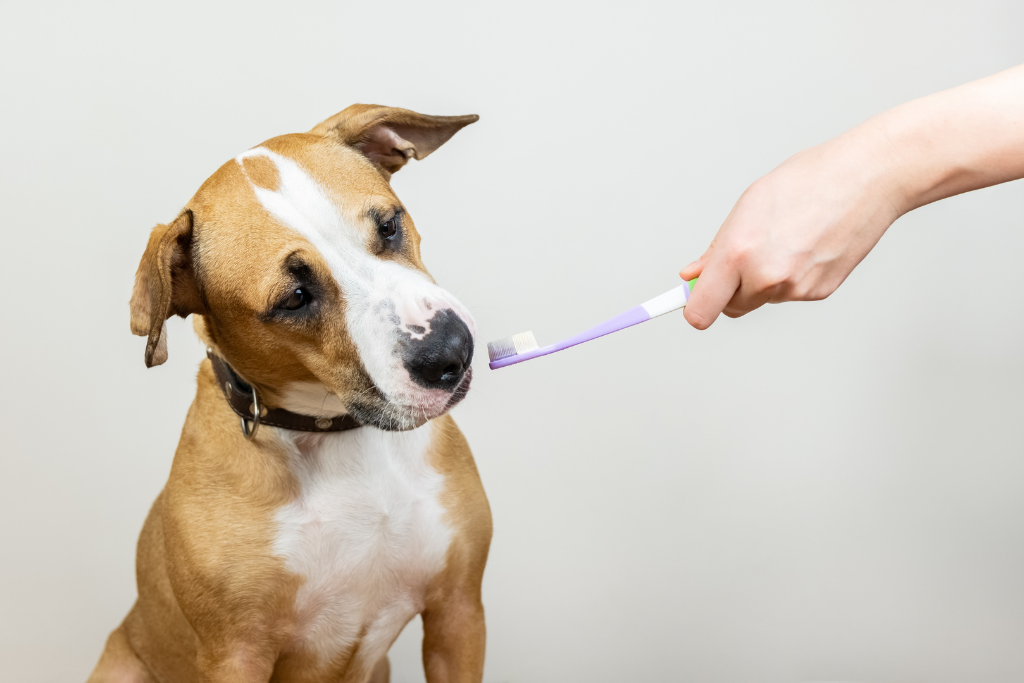

Dental care for pets is often overlooked. We teach our children about the importance of oral health care, so why do we neglect our pets? Our pets rely on us to keep their mouths clean and healthy. Good dental hygiene is directly tied to overall health and longevity for our pets. As pet parents, we want our pets to have healthy mouths. Here are some reasons why good dental care is so critical to our pet’s overall health:
- Preventing Tooth Loss: Good pet dental care will ensure the structures supporting a dog and cat’s teeth stay healthy and keep their teeth in place.
- Preventing Bad Breath: Bad breath will not be a problem when your pet has a healthy mouth and teeth.
- Preventing Oral Pain: Dental disease can become painful for dogs and cats. Keeping their teeth and gums healthy will prevent any pain.
- Preventing Organ Damage: Bacteria in plaque buildup can actually enter your pet’s bloodstream and spread to their heart, kidney and liver. This spread of bacteria, called bacteremia, can damage organs and make your pets quite sick.
- Preventing Worsening Dental Disease: So many pets have dental disease by the time they are three years old. Good dental care can prevent dental disease from becoming severe. It is essential to take preventative measures when your pets are young to avoid dental disease.
Preventative measures against dental disease should begin when your pets are young, but it is never too late to get them accustomed to teeth brushing! Here are some good reminders and tips to ensure the well-being of your furry friend’s oral hygiene:
- Regular exams are important. It is recommended to visit the vet once a year.
- Check your pet’s breath monthly. Bad breath can indicate gum disease.
- Dogs can often disguise how much pain they are truly in. Regularly monitor eating and chewing habits to look for signs of oral distress.
- Check for red, puffy gums and yellow or browning tartar on teeth as signs of concern.
- Supplements and diet play an important role.
- Dental-specific kibble and dental treats can help reduce plaque and tartar.
- Daily oral chews can help improve dental health.
- Look for Veterinary Oral Health Council-approved products.
- Daily brushing is essential in preventing bacteria build-up.
- Use a pet-specific toothbrush or a soft child toothbrush.
- Use pet-friendly toothpaste only.
- Start slow and work up to longer brushing.
Oral care is health care for our furry friends. Feeds’n Needs has a variety of specialty treats, chews and more to help keep your pet’s teeth healthy. Ask our Experts in-store about our favourite oral health care products and what will best suit your pet’s needs!
For more dental health tips for your pets, check out our other blogs:
Dental Health Tips for Your Dog
Dental Health Tips for Your Cat
Source:
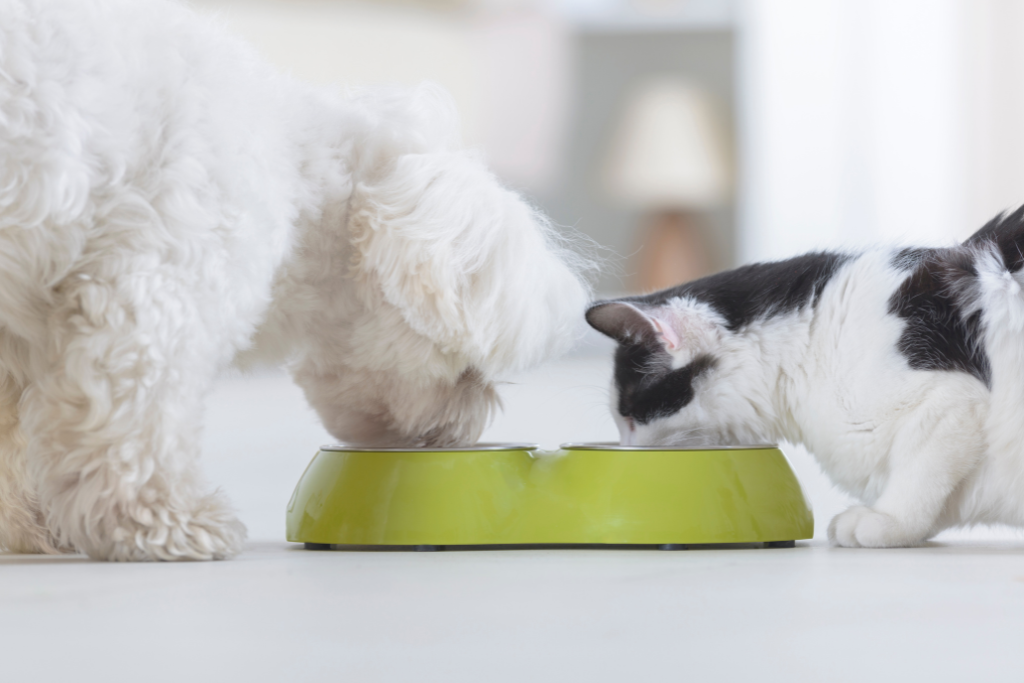

Benefits of a Raw Food Diet
Raw food diets for cats and dogs are becoming more popular! Many people are choosing to feed their pets a raw diet because it is more natural and less processed than kibble. Others feed raw due to the many health benefits of a raw food diet. Here are some of the top reasons you should make the switch to raw:
-
- Joint and Bone Health
The best way to support bones is with bones! Real crushed bone is a natural source of calcium, phosphorus, glucosamine, chondroitin, collagen and marrow. These components result in healthy growth in puppies and maintain superior joint and bone health for your dog throughout its lifetime. - Immune System Support
Raw meat is highly bioavailable and contains live bacteria/enzymes that support digestion and help to absorb almost all the immune-boosting nutrients. Raw food is also naturally rich in moisture, which supports organ health. - Less Stool
Having a diet of highly digestible ingredients for your pet is that more of what goes in is absorbed and utilized within the body – meaning less comes out the other end. Carbohydrates and filler ingredients such as soy, potato, corn and rice take longer to digest and do not fully absorb within your pet’s body. These ingredients can lead to larger stool volume with a heavy odour. Most raw diets contain no fillers and are low in carbohydrates, resulting in less waste passing through and decomposing faster. - Healthy Skin & Coat
Raw diets contain many ingredients that support skin and coat health, one of the most notable being omega-3 fatty acids. Healthy omega fats play a significant role in supporting healthy skin and a soft coat. Some common ingredients that provide essential omega-3 fatty acids include salmon, chia, and flax seeds. After switching your pet to a raw diet, you’ll notice a difference in their skin, coat and even how much less they shed! - Reduced Body Odour
When pets consume food high in fillers, additives, and preservatives, it can lead to unpleasant odours. A raw food diet better supports your pet’s digestive system, which often decreases or eliminates gas. - Weight Management
A raw diet is a natural way to help manage your pet’s weight and improve its overall well-being. Kibble contains carbohydrates and sugars that are harder for your pet to burn off, most times causing weight issues. - Cleans Teeth Naturally
Poor dental hygiene in your pets can sometimes be caused by a poor diet, especially if their diet is heavily processed or high in carbohydrates. Kibble and canned food can often get stuck in your pet’s teeth, leading to plaque, tartar and bad breath. Raw, meaty bones are well-known for helping them get into those tricky places between their teeth and removing plaque. - Reduction in Allergies
A pet’s diet is the most common cause of allergies. Many fillers used in kibble are not biologically meant for pets to digest and can cause stress on their digestive system and compromise their immune system. Common allergic reactions include rashes, itchy paws, ear infections, and digestive and joint issues. Healthy omega fats provide anti-inflammatory benefits, perfect for dogs with allergies or inflammatory skin diseases. A raw food diet can help reduce and sometimes even eliminate your furry friend’s allergy symptoms.
- Joint and Bone Health
These are just some of the many benefits of a raw food diet for your pet. Our Experts here at Feeds’n Needs recommend Big Country Raw for your pets! There is something on their menu for dogs and cats of all breeds, sizes, and ages! Chat with one of our Experts in-store for more information on getting your furry friend started on a raw diet. We are here to help!
Sources:
Health benefits of raw feeding – Guides | Big Dog Pet Foods
The Top 10 Benefits Of A Raw Diet For Your Pet – Top Dog Food & Supply (topdogfoodandsupply.com)


Pet Fire Safety
National Pet Fire Safety Day takes place every year on July 15. It’s a day to learn how to keep your pet safe during a fire. Pets are part of the family, so it makes sense that we would dedicate a day to keeping them safe during one of the scariest situations we can imagine.
It is important to have a plan for your pets and your entire family, along with making your home “fire safe” for everyone! Make sure you have working smoke detectors and fire extinguishers to protect your whole family. Take these eight additional steps to help keep your pets safe:
1. Prevention:
Never leave your pets unattended around an open flame such as a candle or fireplace. Consider replacing your candles with flameless ones. If your dog knocks it over or your cat’s tail brushes it, they’ll be safe. They offer the same ambiance as a real candle, with fewer hazards. It may be best to eliminate the unnecessary open flames in your home entirely.
If you have a fireplace, be sure to watch your pets around them. Most will stay away, but some are curious and may get too close. Toys or other flammable items can accidentally be pushed too close to a fire which could quickly ignite.
2. Keep Your Pets Away From Hazards:
Cooking equipment is a major cause of pet-originated fires. Pets who jump on counters can hit a stove knob, turning the gas on or turning up a flame. If you have a curious pet or one who climbs on top of your counters, consider using knob covers or remove the knobs when you are not around to monitor your pet safely. Keep young or untrained pets away from potential hazards by crating them or securing them in a safe area with a baby gate.
If you know your pet tends to chew on things, make sure to hide loose wires that could potentially cause a fire, and turn them off and unplug them entirely when they are not in use.
3. Make Sure Emergency Responders Know You Have Pets:
A pet alert sign near each entrance to your home is an important pet fire safety step. It tells emergency responders that one or more pets are in your home and might need help. If you crate pets when you are away or sleeping, keep them near a door, so it’s easy for firefighters to find them after entering your home. You can also keep your leashes by the front entrance so they’re visible to first responders who may enter.
4. Make A Pet Fire Safety Evacuation Plan:
Every family should have a fire evacuation plan and do a practice fire drill at least twice a year. Include your pets in your fire evacuation plan and have leashes or carriers at easy access.
5. Consider Monitored Smoke Detectors:
For pet fire safety you may want to think about upgrading your smoke detectors. Consider using monitored smoke detectors. They are connected to a monitoring center so emergency responders can be contacted when you’re not home or at least send your phone a notification.
6. Know Where Your Pet Is Likely To Hide:
In case of a fire, your pet will probably be scared, especially if a loud fire alarm goes off. Know where your pet is likely to hide inside your home.
Unfortunately, if you can’t find them quickly, get outside and leave the door open for your pets to follow. Call for them to help them find their way and let firefighters know that pets are still inside.
7. Make Sure Pets Aren’t Lost During Evacuation:
A fire is a scary situation, and pets may run off. Another important pet fire safety step is ensuring your pets have a microchip before an emergency and that the information on the chip is up to date.
8. After A Fire, Watch Your Pet Closely:
If your pet acts lethargic or has trouble breathing, it could be a sign of smoke inhalation. See your veterinarian as soon as possible for any needed follow-up care.
Following these tips could help you prevent a fire or even save your pet’s life if an emergency occurs. Preparing ahead of time for pet fire safety can go a long way toward reducing risk. Spend some time this week developing your pet fire safety plan!
Sources: Pet Fire Safety: 8 Ways to Keep Your Pets Safe (bettercitiesforpets.com)
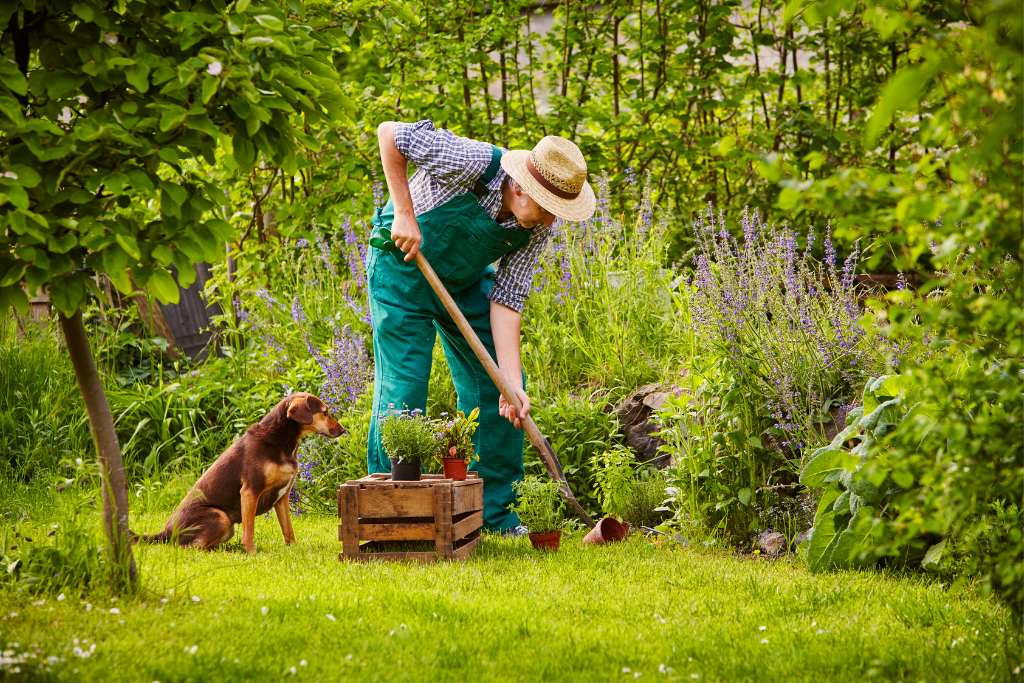

Springtime Garden Pet Safety
Gardening season is upon us, and for us pet owners, that means we need to be aware of how to keep our pets safe from hazardous spring plants! There are few effective treatments for toxic plant ingestion, so it’s important to know the potential dangers spring plants can have on our furry friends.
Most common toxic spring plants:
- Tulips, Daffodils, Narcissus, and Hyacinths – The skin at the bottom of bulb flowers is dangerous to both dogs and cats, but they are especially toxic to dogs. Make sure your dog isn’t digging up the bulbs in the garden! If ingested, it can cause vomiting, diarrhea, and drooling.
- Lilies – These are highly toxic to cats. The pollen, leaves, stems, and even the water in a vase can cause kidney failure, even small ingestions such as 2-3 petals or leaves.
- Irises – These are considered toxic to both dogs and cats. All parts of the iris contain harmful components, but the bulbs are the most dangerous part. If your pet ingests an iris, it can cause vomiting, diarrhea, and drooling.
- Begonias – The underground stem can cause severe mouth irritation for both dogs and cats.
- Buttercups – These flowers can cause your pets to have an upset stomach if ingested.
- Crocus – The spring Crocus may cause gastrointestinal upset like vomiting, diarrhea, and drooling if any part of the plant is ingested by dogs or cats.
- Lily of the Valley – This plant can cause symptoms such as vomiting, diarrhea, a drop in heart rate, severe cardiac arrhythmias, and possibly seizures.
It’s also important to be mindful of fertilizers as these often contain bone, blood or feather meal which ingesting in large quantities can cause vomiting and diarrhea. Next time you visit your local Feeds’n Needs store, be sure to ask our Experts for advice on safe fertilizers to use as a pet owner! You can also keep your curious furry friend away from the garden by fencing it off.
Educating yourself about these springtime hazards will help you, and your pet enjoy your backyard with no worry!
Sources:
Springtime Hazards: Protect your Pets From Toxic Plants | 24Petwatch
Spring Dangers To Pets | Pet Poison Helpline


Dental Health Tips For Your Cat
How often do you brush your cat’s teeth? It is suggested that owners should brush their companion’s teeth after every meal, or at least once a day to keep their dental health in check. Did you know that once a cat reaches the age of three, they’re more likely to experience issues related to their dental health? Check for signs of bad breath, drooling, lack of appetite or repetitive shaking and pawing at their mouth for signs of a potential issue. If left untreated, poor dental hygiene can lead to more serious conditions, including kidney and heart disease. Many owners find that putting anything in a cat’s mouth to be a tricky, squirmy process, so here are a few tips to keep in mind when thinking about your furry friend’s dental health.
It is important to get into a habit of checking your cat’s teeth and gums for problems – the sooner you start, or earlier in your cat’s life you establish these habits, the better and more cooperative and patient they’ll be during teeth brushing and check-ups. Start by gently lifting their upper lip to check for red, swollen gums, or tartar build up on their teeth for indications that it’s time for a check in at the vet.
Use a pet-safe, cat-friendly toothpaste. Let one of our experts help you find a toothpaste in-store that will keep your cat interested and distracting during the brushing and cleaning process.
When it comes to selecting a toothbrush for your cat, opt for a human baby-sized or pet toothbrush, or a rubber finger slip that goes over your finger that allows you to graze over their teeth.
Reward with some catnip throughout the process to make it a pleasant experience for your kitty. We carry many great brands that are specifically formulated and coated to clean your pet’s teeth while chewing. Greenies Dental Treats are a great option for this, as they freshen breath while the treats’ textured surface helps remove tartar buildup. Ask our Experts in-store which treats they recommend!

Watch our Tick Webinar Recording with Dr. Nicolette Faraone
We were fortunate to have Dr. Nicoletta Faraone, PHD. join us for a tick webinar to teach us all about tick safety and prevention! Dr. Nicoletta Faraone is an assistant professor at the Chemistry Department, Acadia University, Wolfville (NS). She teaches Biochemistry and Natural Product Chemistry. Her research focuses on studying tick chemosensory system, how ticks detect odours from hosts and how they respond to repellents. She designs and develops novel essential oil-based tick repellent products. In this one hour long webinar, customers had the chance to learn from Dr. Faraone and ask their questions. If you missed the live webinar, you can watch the recording below!
For more Expert Advice on products we carry to protect your pets, click here.
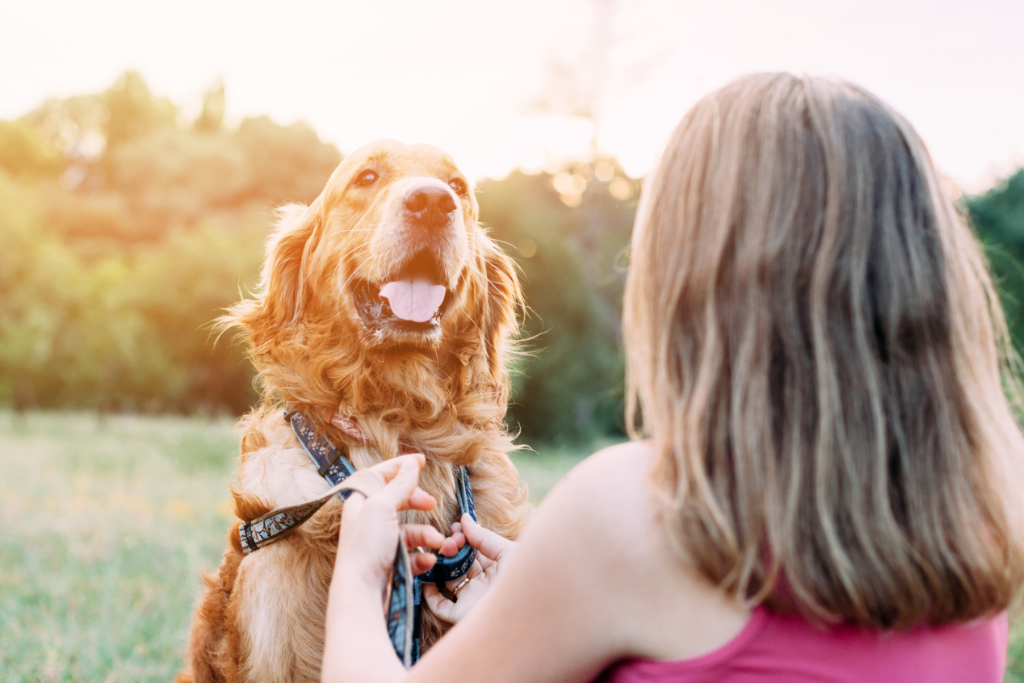
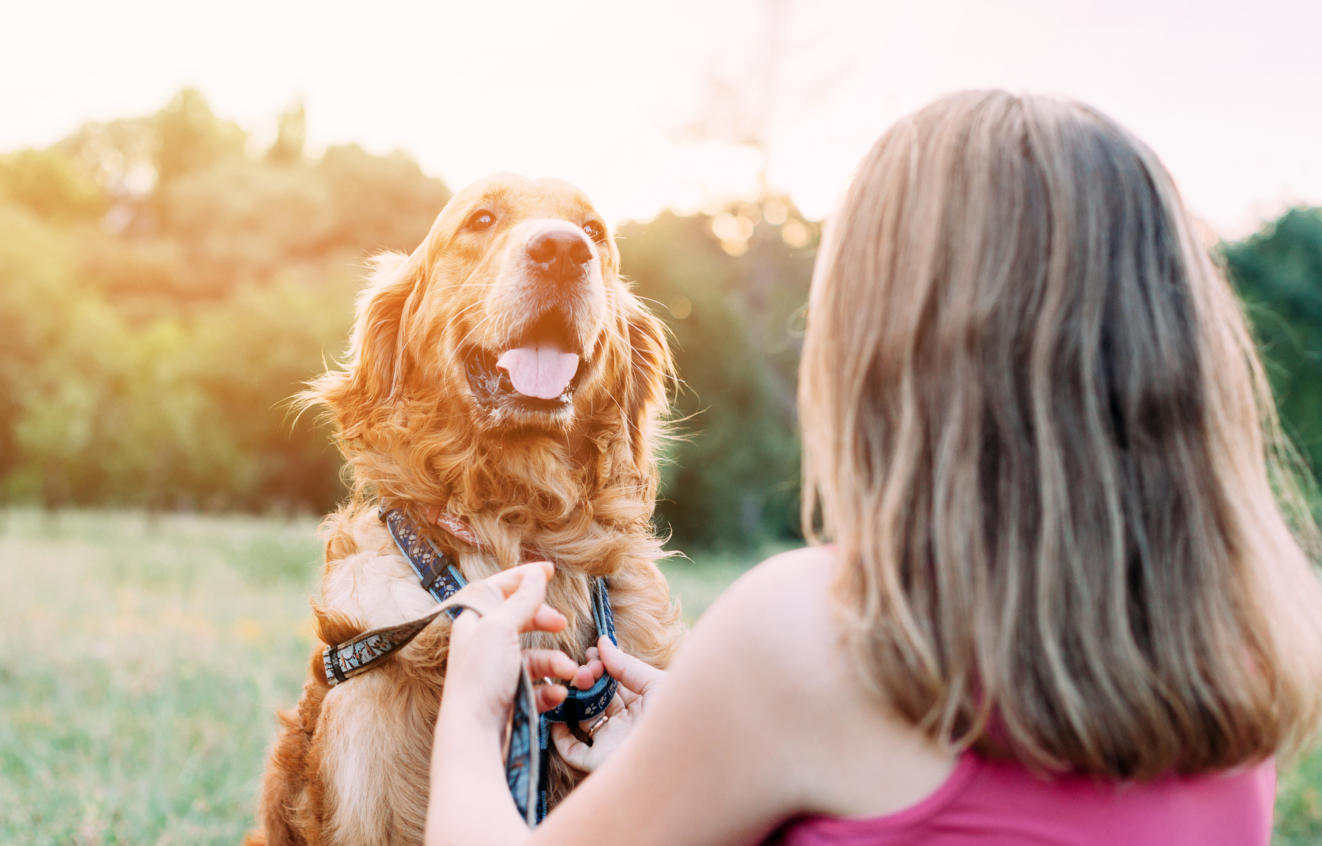
Keep Tick Safety Top of Mind This Spring and Summer
Its spring, which mean it is tick season here in the Maritimes. As the weather warms up, it’s important to remember that ticks will be more present within our communities and the places we love to adventure with our pets. Whether you are letting your dogs out in your yard, or heading to a local trail to get some exercise, you will need to be diligent about checking for ticks on both you, and your pet. Here are a few Tick Tips to ensure you and your pet’s safety this season!
Where ticks are present:
Ticks are small so it can be difficult to spot them not just on your pets, but where you are outside that they could be hiding. The most popular ticks in our area are called Blacklegged ticks, or commonly known as deer ticks. Ticks can be as small as the size of a poppy seed, so be vigilant! Typically, ticks can be found in tall grass, woods, shrubs, walkways and trails.
Ticks can also be found in your own backyard. In fact, most people contact Lyme disease from ticks within 100 yards of their own homes in areas with woods or tall grass. If you are doing some spring cleaning around your yard, be careful of the shrubs, sticks and trees when you are doing your chores in preparation for the summer.
Pet owner tip: if you are doing yard work, wear long pants and boots and wear clothing that is light in colour so you can easily identify a tick. Spray yourself with repellent and remember to take a hot shower once your yardwork is complete.
Where to check your pet for ticks:
The more frequently you check your pet, the more likely you are to locate ticks before they fully latch onto your cat or dog. Here are a few places they like to hide on your animals.
Ears: In and around the ears are popular places for ticks to hide. They could even be inside your pet’s ears! If your dog has floppy ears, be extra vigilant of this area.
Between the toes: Check in between each toe of your pet, on each paw. Ticks like to burrow in between these areas as they are drawn to dark, warm places.
The tail: Naturally your pet is going to be happy when they are out adventuring, but this makes for some extra wagging in areas where ticks hide. Check at the base of the tail and your pets groin for ticks.
Under the collar: Your pet’s neck is another likely place for ticks to latch onto. It can be extra difficult to spot ticks in this area, especially with pets who have lots of fur or scuff on their neck area. When it’s safe, remove your pet’s collar and check for ticks underneath it where they might be burrowed.
Under back and front legs: while this may seems standard, it’s important that this area is checked as carefully as other furry areas on your pet!
How to prepare for tick season and protect your pet:
Preparing your tick season means beginning with preventatives for your pet. It’s important to talk to your vet before choosing a treatment to best suit your pet’s needs. At Feeds’n Needs, we carry many preventatives, topical treatments (Infestop, Advantix, and Advantage products), oral preventatives, sprays (Zodiac and Atlantick) and many tick accessories (tick removing tools, shampoos, etc.) in-store! Ask our Experts for help regarding tick safety on your next visit, and remember to always check your pet for ticks!

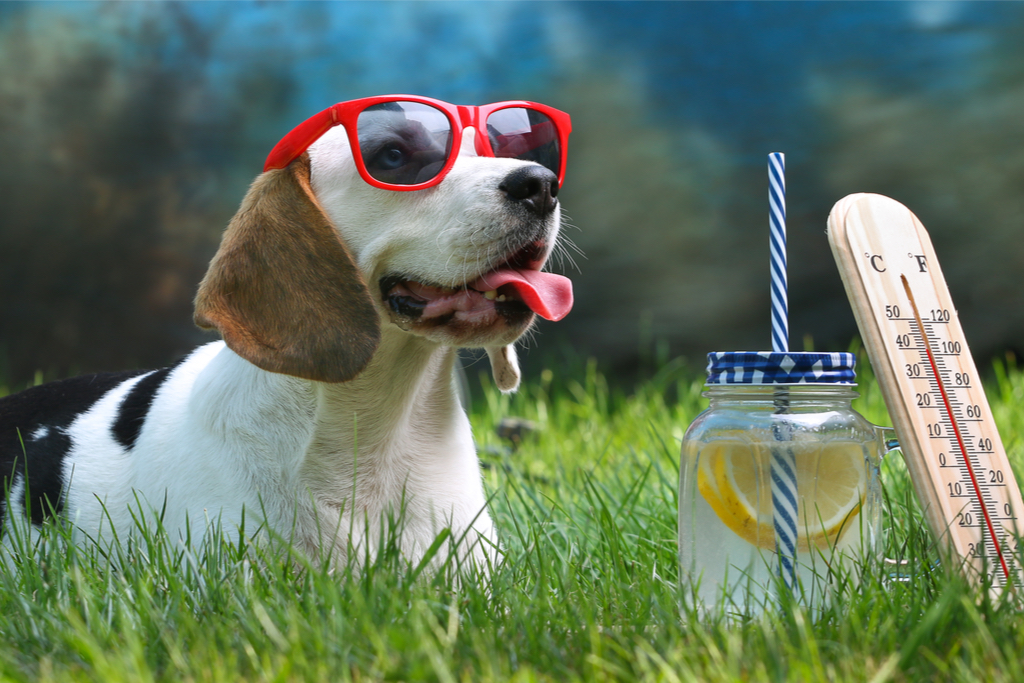

Animal Welfare During a Heat Wave
On hot days, it’s important to think about our four legged friends because chances are, they are probably hotter than you are. This article offers a few tips and solutions to help you keep your animals comfortable and cool during hot weather. Be sure to think about animal welfare during a heat wave!
Keep your pet well hydrated
No surprise here! Like their owner, animals must stay hydrated at all times and even more during hot periods. Make sure to give your pets water as often as possible during the day. The same goes for animals on farm. Think, for example, of cows, pigs or even horses, who drink large amounts of water on a normal day. Add a heat wave or drought in there and their water needs significantly amplify. Offer several areas on your property that allow for animals to have easy access to water, either on the ground, around the building or in your home.
Place ice cubes in the water to keep it cool. One trick to encourage your pet to drink more frequently: put bowls of water throughout your house, instead of having one spot they can go to drink. When going out with your pet, bring more water than you think is enough for yourself and your companion. Also, try to avoid going out in peak heat times (afternoon) and aim instead to go in the morning or the evening when the weather cools down.
If the pavement is too hot, consider putting booties on your pet so they don’t injure or burn their pads. If the weather is too hot, indoor activities are best. Consider playing games to develop the animal’s mental faculties, to allow them to burn energy while avoiding the hot sun.
Avoiding the sun
Close curtains and blinds to prevent the sun’s rays from entering and heating the house. For bird owners, try as much as possible to keep them away from the windows. If allowed, installing a small shaded kiddie pool can prove to be the perfect refreshment tool for dogs who love the water and swimming.
If you are on a farm, try to have a few places on land where animals can shade, like a shelter.
Identifying heatstroke in your pet
It is crucial to know how to recognize heat stroke in a pet! In case of heatstroke, the animal should see a veterinarian without delay. Here are some important symptoms to watch out for:
- Vomiting
- Diarrhea
- Bright red gums
- Disorientation
- Body temperature exceeding 40 degrees Celsius
When transporting your animal to the vet, cool it with a cold towel over their body. Do not use ice cubes.
Also, watch out for dogs with flat noses, older animals and young people. They are more at risk of having difficulty breathing during heat waves!
Other tips and tricks
Here are some additional hips to keep your pets cool at all times:
- Freeze a bottle of water and wrap it in a kitchen towel. Then place the cold bottle near the places where you pet is resting. Your animal should stay near it to cool down.
- Brush your pet often. A tangle free coat will be more comfortable for your pet, especially on a really hot day.
- Leave a cold water base in the bath so that your companions can soak their paws from time to time.
During periods of extreme heat, get in the habit of observing the behavior of your animals and make sure they don’t lack any water or shade. Thanks to these tips, you now have some handy tools up your sleeve to make the hot days more pleasant and much safer for your animals!
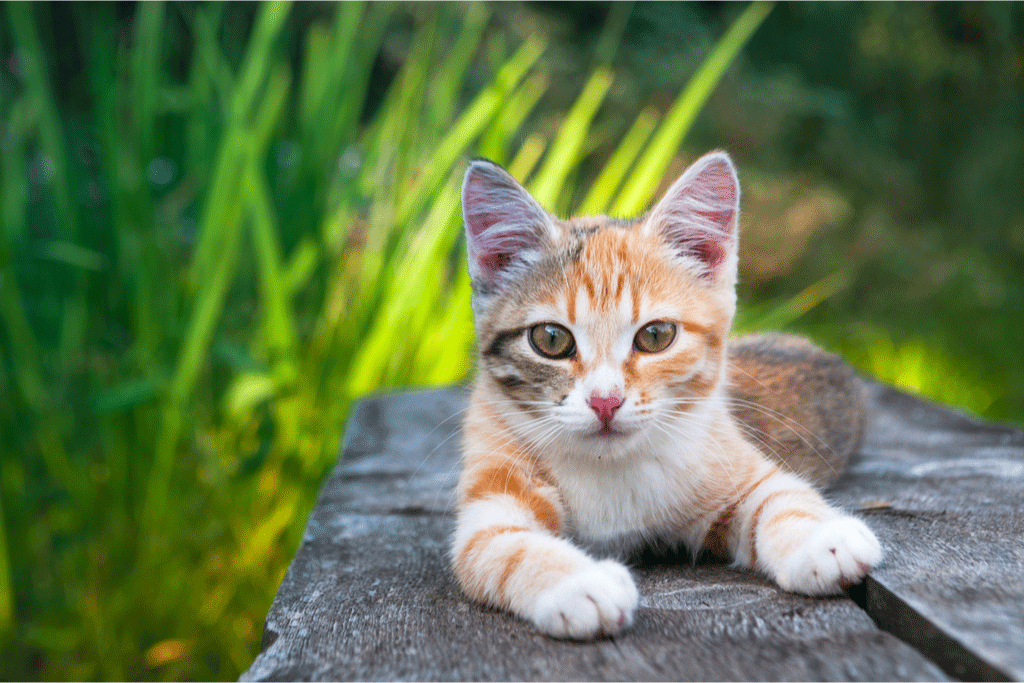

Outdoor Safety for Indoor Cats
Many owners with indoor cats are concerned when it comes to letting them out of the house, so we wanted to provide a few tips and tricks for outdoor safety for indoor cats.
First thing’s first: allow your cat to get used to its new environment
If you just brought your cat home for the first time to welcome he or she into your family, it can take several weeks, if not months, before your cat adapts and realizes that your home is permanent for them. A cat who has to get used to their new home must be able to create scent and visual cues to help them feel comfortable in this new, exciting environment. If a cat goes out too early without having any landmarks, it is more likely to get lost once it leaves the house.
Their first outing
So you are ready to let your cat explore the great big world (okay, maybe just your backyard). Firstly, it’s critical to make sure your kitty is equipped with a way to be identified in case you can’t locate them. A collar with their name and your contact information, or a tracking chip are two options to consider before any outing, and should work well if your cat ever goes missing in your neighbourhood. Vaccines against certain feline diseases, in addition to preventative treatments against ticks and fleas are also things to remember before letting them out.
It’s important to provide a calm and safe environment for your pet on their first outing. If you take them out, make sure you’re able to watch them at all times. Closely observe your cats behaviours to make sure they’re at ease and aren’t showing signs of stress. The first few outings should be kept rather short (15-20 minutes), and can be increased as your cat gains confidence outside.
If you find your cat to be more anxious or nervous in nature, taking them outside with a harness to make sure they don’t wander too far away from you is recommended. If you choose to put them in a harness, make sure they are accustomed to wearing it before they head out. It may take a few weeks before he or she is fully comfortable, but you could speed up the process by rewarding them with treats when they are wearing it and are remaining calm.
So you took them outside and all was well. When you return back inside, give your cat some treats! That way, he’ll associate the outing with something positive and rewarding, and will be less reluctant to come back inside in the future.
Why you should take your cat out (if they like it)
For the “outdoor cat” type, there are certainly benefits of letting them outside.
If your cat is comfortable outdoors, one obvious benefit is that the outdoors is one giant, natural litter box! More importantly, being outside will satisfy your cats natural hunting instincts and allow them to expend their energy in a different yet always-stimulating environment. Not only is this great for their physical health, but like humans, cats reap the great mental benefits of getting some fresh air and connecting with nature.
Every cat is different. Not all cats are ones that like to be outdoors, and indoor cats can still live a long, healthy and happy life by staying inside.
If you ever have any concerns or questions with taking your cat out, it is always best to contact the veterinarian who takes care of your companion for advice.


Can a Cat Attach to its Owners?
Have you ever wondered if cats could attach to its owners? Have you ever thought maybe your cat doesn’t like you because they are more of the lonely type? Well, you might be delighted to hear that you could be wrong! A study by Oregon State University concluded that, like dogs, cats actually do become attached to their owners and have been proven to be a source of comfort for the cat.
How do cats recognize their owners?
Contrary to what you might think, cats can recognize their caretakers amongst a crowd of people, but not through vision. Cats cannot distinguish their master through sight. So as unique as you are, your cat can’t pick you out from the crowd based on your good looks. Your cat has to rely on their highly developed senses of smell and hearing to find you! Moreover, cats are accustomed to decoding their owner’s behaviours and habits. This gives them more to pick up on using their elements.
Your cat cares about you!
Like a dog or a human baby, cats develop an attachment to their owners over time. The study determines that cats can have an ambivalent attachment toward their owners. This might ring true to a few cat owners who think their cat may not be as “loving” towards them but still loyal and accustomed to their routines. Cats who are ambivalent tend to be less affectionate and may show signs of stress around their owners, such as wagging their tail, licking their lips and avoiding them.
On the other hand, for most cats, humans are a sign of comfort and safety in times of stress. Cats get used to the routines you have created for them. They tend to have trouble adapting to changes in that routine, for example, when you go away for the weekend. The study mentions that when cats are in the presence of their master, even after a short time away, it makes them less stressed and shows more signs of comfort. So yes, even when you may not always feel the love from your cat, at the end of the day, they do love you! You may find even more comfort in knowing that the study proves that the connection you have with your cat (whether your cat is attached to you or uncertain) remains totally stable over the years. A happy ever after!


